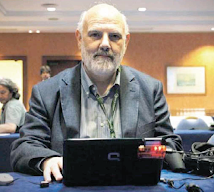Hungary's unemployment rate declined in the second quarter from the first to a seasonally adjusted 7.6 percent, which compared with the 8 percent registered in the January-March period, according to the national statistics office (KSH) in Budapest earlier today.

The number of Hungarians employed at 3.87 million was up over the 3.84 million in the first quarter but down when compared with the 3.94 million registered in the second quarter of 2007. The last time the number of employed in Hungary was this low during the second quarter was in 2002. The number of employed was down by over 70,000 since end-June 2007, while there were some 20,000 more unemployed and 50,000 more inactive people in April-June than in the same period of 2007.

Thus we find that more than 50,000 people have “disappeared" from the Hungarian labour force in the space of a year.

So the central bank now has a problem, since as people leave the labour market to retire the labour market also tightens, reducing the room for monouevre in reducing interest rates due to the continuing pressure on wages, even as economic growth approaches stagnation point.











2 comments:
There is a second solution to the puzzle. The unskilled people make a living on very low paid seasonal work. During harvest, from early summer till mid-autumn day may disappear from the statistics as they do not claim unemployment or social benefit, and thus they also disappear from the employment statistics and they come back in the winter. Although the social benefit system is always changing, because of the time limits and seasonality of unskilled work (due to the continental climate there are not much construction in the winter, either) there is a big movement on the lowest paid part of the Hungarian labor market.
Hi Daniel,
I hope you are well.
"There is a second solution to the puzzle. The unskilled people make a living on very low paid seasonal work. During harvest, from early summer till mid-autumn day may disappear from the statistics as they do not claim unemployment or social benefit,"
Well, yes. I agree. But what I don't see is how this is going to help us that much with the problem in hand, since I am making year on year comparisons with employment. Now admittedly last year was a very bad harvest, and this year may be a very good one, and hence the wages in agriculture may be more attractive or something.
But look. I am just doing a substantial study of Portugal, and what I am seeing here is so similar in many ways to what happened in Portugal in the late 1990s. I am convinced of this. That is there is a big underlying problem coming associated with declining and ageing population - Portugals population declined in the mid 1990s following lifting of EU membership restrictions - and yet few seem either to want to see it, or to talk about it. Until it is too late of course.
Post a Comment